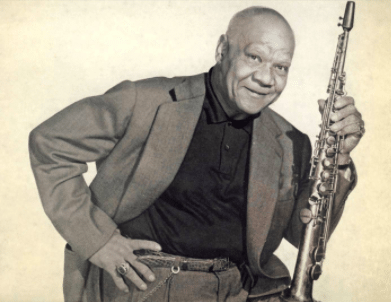Sidney Bechet (May 14, 1897 – May 14, 1959) was an American jazz saxophonist, clarinetist, and composer. He was one of the first important soloists in jazz, beating trumpeter Louis Armstrong to the recording studio by several months. His erratic temperament hampered his career, and not until the late 1940s did he earn wide acclaim.
On September 15, 1925, Bechet and other members of the Revue Nègre, including Josephine Baker, sailed to Europe, arriving at Cherbourg, France, on September 22. The revue opened at the Théâtre des Champs-Élysées, Paris, on October 2nd. Bechet toured Europe with various bands, reaching as far as Russia in mid-1926. In 1928, he led his own small band at the Bricktop’s Club in Montmarte, Paris.
Bechet was jailed for 11 months in Paris when a woman passerby was wounded during a shoot-out. The most common version of the story, as related in Ken Burn’s documentary film Jazz, is that the shoot-out started when another musician-producer told Bechet that he was playing the wrong chord. Bechet challenged the man to a duel and said, “Sidney Bechet never plays the wrong chord.
In the 2016 film La La Land, the character played by Ryan Gosling tries to persuade the character played by Emma Stone that jazz is not “relaxing”, saying: “Sidney Bechet shot somebody because they told him he’d played a wrong note, that’s hardly relaxing
Learn More About Sidney Bechet
Petite Fleur - Ocean’s Eight - 2018
St Louis Blues - You’re Not You - 2014
House Party - Blue Jasmine - 2013
Si tu Vois ma Mère - Midnight in Paris - 2011
Big Butter and Egg Man - The Curious Case of Benjamin Buttons - 2008
Si tu vois ma mere - All the King’s Men - 2006
Mon Homme - The Quiet American - 2002
Blue Horizon - Hart’s War - 2002
Wild Cat Blues - The Cat’s Meow - 2001
Promenade aux Champs-Élysées - Chocolat - 2000
Viper Mad - Sweet and Lowdown - 1999
Sweetie Dear - Sweetie Dear - 1998
Francis Blues - JFK - 1991
Tropical Mood Meringue - Stardust Memories - 1980
Load More
This Jazz Inspiration Profile of Sidney Bechet is sponsored by Sacramento Top 10, the best local list of home improvement contractors, real estate, restaurants and more.


